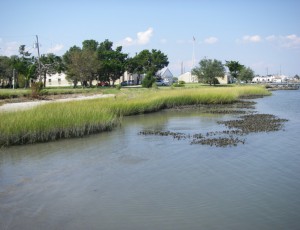
A living shoreline in Beaufort, North Carolina. Image by Carolyn Currin
On Oct. 28, the National Oceanic and Atmospheric Administration (NOAA) released Guidance for Considering the Use of Living Shorelines. The agency encourages the use of living shorelines to protect sheltered coasts — those not exposed to open ocean wave energy — from intense storms, erosion, and sea level rise.
Living shorelines include a range of shoreline stabilization techniques but generally incorporate vegetation or other natural elements. These elements can be used alone or in combination with more stable structures, such as oyster reefs or rocks.
Along the U.S. coast, the current rate of shoreline hardening — the traditional process of armoring the coast with approaches like sea walls, bulkheads, or riprap — is about 200 km per year. If shoreline hardening continues at this pace, NOAA reports that nearly one-third of the contiguous US shoreline is expected to be hardened by 2100. These figures are based on a 2015 analysis of shoreline hardening published in the journal Frontiers in Ecology and the Environment.
According to NOAA, living shorelines have outperformed hardened shorelines during storm events. Traditional techniques create a barrier between land and water and actually can increase erosion. In contrast, living shorelines not only reduce erosion and enhance coastal resilience, they also provide habitat value and improve water quality.
To help coastal communities implement living shorelines, the NOAA document includes guiding principles as well as the agency’s applicable science, tools, and training. The document also covers how to navigate NOAA’s potential regulatory and programmatic roles in living shorelines project planning and questions to consider when planning a shoreline stabilization effort.
SIDEBAR
On Oct. 21, The Dow Chemical Company and The Nature Conservancy released a study focusing on how nature can help protect business assets from natural disasters. The study demonstrates that asset protection strategies can include green infrastructure ― such as marshes and mangroves as well as coral and oyster reefs ― along with more conventional infrastructure ― such as dykes and levees ― to protect business assets from hurricanes and flooding. Read more.




